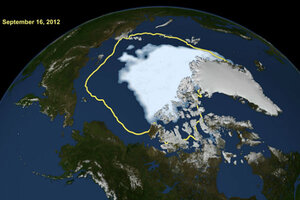Arctic sea ice in 'uncharted territory,' say researchers
As Arctic sea ice melted to the lowest level ever recorded, researchers said they were unprepared for the speed of this facet of climate change. As Arctic ice melts, scientists worry it will add heat and moisture to the globe's climate system.

This image shows the amount of summer sea ice in the Arctic on Sunday, Sept. 16, 2012, at center in white, and the 1979 to 2000 average extent for the day shown with the yellow line. Sea ice in the Arctic shrank to an all-time low on Sunday, Sept. 16, 2012.
AP Photo/U.S. National Snow and Ice Data Center
WASHINGTON
Arctic sea ice, a key indicator of climate change, melted to its lowest level on record this year before beginning its autumnal freeze, researchers at the U.S. National Snow and Ice Data Center said on Wednesday.
The extent of ice probably hit its low point on Sept. 16, when it covered 1.32 million square miles (3.42 million square km) of the Arctic Ocean, the smallest amount since satellite records began 33 years ago.
Changing weather conditions could further shrink the extent, the center said. A final analysis is expected next month.
The record was broken on Aug. 26, when the ice shrank below the record set in 2007. After that, it kept melting for three more weeks, bringing the ice extent - defined by NSIDC as the area covered by at least 15 percent ice - to nearly half of the 1979-2000 average.
"We are now in uncharted territory," Mark Serreze, the center's director, said in a statement. "While we've long known that as the planet warms up, changes would be seen first and be most pronounced in the Arctic, few of us were prepared for how rapidly the changes would actually occur."
The summer ice isn't just dwindling. It is also thin, relatively fragile seasonal ice instead of the hardier multi-year ice that can better withstand bright sunlight.
"The strong late-season decline is indicative of how thin the ice cover is," said NSIDC's Walt Meier. "Ice has to be quite thin to continue melting away as the sun goes down and fall approaches."
The Arctic is a potent weather-maker for the temperate zone, and is sometimes dubbed Earth's air conditioner for its cooling effects. However, as ice wanes and temperatures rise in the far north, the Arctic could add more heat and moisture to the climate system.
More extreme weather?
"What happens in the Arctic doesn't stay in the Arctic," said Dan Lashof, a climate scientist at the nonprofit Natural Resources Defense Council. "This has a real impact on Americans where they live and work."
Melting Arctic ice changes the shape and position of the jetstream, allowing tropical air to penetrate further north and Arctic air to penetrate further south, Lashof said in a telephone interview, leading to more extreme weather.
"That is a truly staggering rate of melting, far beyond what scientists thought would happen a few years ago," Bob Ward of the London School of Economics and Political Science said in a statement. "Policy-makers need to wake up to the scale and pace of the impacts from climate change."
Recent climate models suggest the Arctic could be free of ice before 2050. But the observed rate of melting is faster than what is shown in many of the models, according to NSIDC scientist Julienne Stroeve.
Both the Northwest Passage along Canada's coast and the Northern Sea Route along Russia were open to traffic this summer, and investors gathered in Alaska last month to discuss commercial and transportation opportunities for the Arctic.
The environmental group Greenpeace International took issue with that approach.
"Rather than dealing with the root causes of climate change, the current response from our leaders is to watch the ice melt and then divide up the spoils," the group's executive director, Kumi Naidoo said in a statement.

